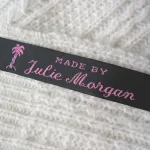Use Clothing Labels to Determine Whether Clothes Are Truly Vintage (Part II)
This is part two of a two part blog series where we look back at clothing labels and changes in the clothing industry since the 1940s. Part one covered the time period from the 1940s through the 1960s. This blog post picks up with the 1960s and continues through today. As clothing importation continued to expand in the late 1960s and 1970s, another country that clothes started to come from was (South) Korea. Labels from this time period simply stated the apparel was “Made in Korea.”
It was also during the 1970s that a division between high-end fashion houses and bulk manufacturers started to take shape in regards to labeling. Bulk manufacturers started using inexpensive labels on their clothing, while the high-end fashion houses continued to use higher quality labels. Another useful tip, when looking at vintage clothing, is that use and care instructions did not start to become a standard until the early 1970s. Prior to this time, not all manufacturers included a use and care label on their clothing products.
Changes in technology in the late 1970s and early 1980s saw another change in how manufacturers used labels. Thanks to computers, mass clothing producers started printing information on labels instead of stitching it. This trend did not last long and, in the late 1980s, manufacturers returned to using high quality labels with sophisticated designs. All labels on clothing were embroidered, and not just the store name or manufacturer, but also the size, material content, where it was made, and the use and care instructions.
The 1980s saw a shift in clothing imports from Hong Kong and Korea to China, India, and Taiwan. Another unique change in the fashion and clothing industry was the resizing of women’s clothing. It was during the 1980s that sizes like 2, 4, and 6 started appearing on apparel. Manufacturers believed, by adjusting clothing sizes and making them smaller, it would make women feel better about themselves, and they would buy more clothing.
In the 1990s, mass clothing manufacturers continued to improve the quality of their labels. A return to more elegant designs used during the 1940s and 1950s started to reemerge. Another popular trend was the appearance of “Dry Clean Only” on labels found on a significantly larger number of garments. Just about everything sold at retail clothing stores during the 1990s said it had to be dry cleaned.
Today’s labels continue to evolve and incorporate graphic art designs. Labels are considered a work of art by many designers to highlight their fashion designs, whether they are mass produced or made by high-end fashion houses. Some manufacturers have even started using retro-inspired themes for their label designs. This can make it confusing and difficult to find truly vintage clothing. In order for you to find truly vintage clothing from past decades, let’s review the key points from our two recently weekly blog posts:
- Sizes were larger and typically ran twice the size of today’s sizes (i.e. today’s size 6 tended to be a 12 or 14).
- Synthetic fabrics were not invented until the 1960s, and manufacturers were keen on making sure consumers knew the exact percentage blend used in the clothing.
- Use and care labels were not required until the early 1970s.
- Look at where the clothes were manufactured and remember: Clothing imports only came primarily from Hong Kong and Korea from the 1950s until the early 1980s.
- Look at how the labels were made and the quality of the label.
Hopefully, you have learned how to identify true vintage clothing from our two-part blog post. For vintage-inspired clothing labels to add your own uniqueness to your vintage-inspired, retro clothing creations, contact It’s Mine! Labels by phoning 1-866-695-2235 now.


